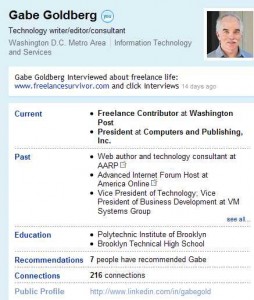by Gabe Goldberg
Now that you’ve joined LinkedIn — maybe colleagues or friends invited or nagged you, maybe you signed up after reading about it — and created a basic profile, you may wonder what to do next. The good news is that taking a few simple steps will give you a complete profile and let you use and enjoy the service for effective professional, and personal networking.
Unless you want to use and explore LinkedIn at random — and there’s nothing wrong with that, since it can be interesting and fun, though it can miss opportunities — consider what you’d like to accomplish. Having goals in mind helps plan what to do.
Since a prime reason for using LinkedIn is being found, it’s worth working on your profile. LinkedIn will guide you, suggesting adding information such as education and past jobs, and collecting recommendations. Each nugget added — including photo! — raises your profile’s completion percentage.
To help people find you, tailor your profile to something better than the LinkedIn numeric default.
Mine is on my business card and in my email signature.
LinkedIn is all about making connections. But do this selectively, only linking to people you know and trust. On this Web site, your reputation is affected by your connections; you are who you link.
Search for and connect with current and former colleagues with whom you share interests. It’s OK to connect with friends — but not too many: This also isn’t Facebook. Occasionally explore your contacts’ contacts for people you know.
When inviting people to connect with you, customize message text sent so
it doesn’t look like a form letter.
Keep a clean profile. Don’t post anything that might embarrass you or colleagues. Everything you post is public and forever.
Remember that people can find you even if you don’t look for them or point them to your profile. Everything you post makes it harder to be anonymous online.
Be careful about — or simply don’t — importing contacts/email lists. While you may intend contacting people selectively, a mistake can result in a mass mailing to everyone you know, from past loves to the local deli owner.
Join LinkedIn groups to find people with shared interests. Some groups are open to anyone interested while others require approval to join. Watch groups’ discussions and question/answer dialogues. Use the Q&A facility to gather information yourself and to help others. The more information you provide and the more you credibly participate in
discussions, the better your reputation will be. To follow members’ news and discussions, subscribe to group updates.
Another area affecting online reputation is recommendations. LinkedIn allows members to recommend each other, describing how someone was valuable, helped, contributed, etc. Use these praise items judiciously, offering and requesting. Don’t recommend everyone to whom you’re linked and don’t request everyone you know to chime in about your delights. A few significant items beats dozens of rote recitations.
Don’t simultaneously recommend and be recommended by someone; that always appears in status updates as an obvious exchange rather than meaningful feedback.
If you use Firefox, install the LinkedIn add-on to simplify bookmarking interesting profiles.
Finally, explore Account & Settings to tweak your membership towards perfection.
Remember that LinkedIn membership is ongoing participation and refinement rather than than a one-time event — you needn’t do all this at once. Join, create a profile, participate, learn, and you’ll discover what’s most valuable, interesting, and fun.
Gabe Goldberg (tiplet@gabegold.com), a lifelong computer pro and technology communicator, has written three books and hundreds of articles for audiences including techies, baby boomers and senior citizens. He enjoys sharing tips and pointers that help people use and have fun with technology.

